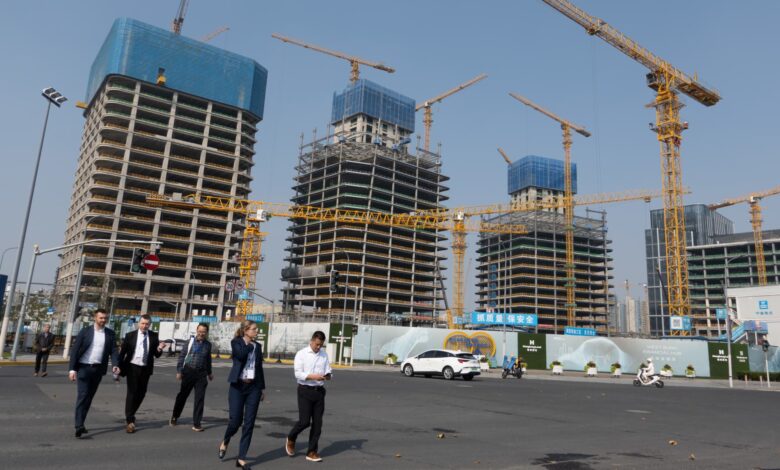China announces $1.4 trillion package over five years to tackle local governments’ ‘hidden’ debt

Pictured here is a construction site of property developer Hongkong Land, in Shanghai on Nov. 4, 2024.
Feature China | Future Publishing | Getty Images
BEIJING – China on Friday announced a five-year package totaling 10 trillion yuan ($1.4 trillion) to tackle local government debt problems, while signaling more economic support would come next year.
Minister of Finance Lan Fo’an told reporters Friday that authorities planned to “actively use” the available deficit space that can be expanded next year. He called back to October, when he had said that the space to take this step was “rather large.”
His comments, translated by CNBC, came after the standing committee for China’s parliament, the National People’s Congress, on Friday wrapped up a five-day meeting that approved a proposal to allocate an additional 6 trillion yuan to increase the debt limit for local governments.
The program takes effect this year and will run through the end of 2026 for around 2 trillion yuan a year, Lan told reporters.
He added that, starting this year, central authorities would issue an annual 800 billion yuan in local government special bonds over a five-year stretch, for a total of 4 trillion yuan.
The policies would contribute to local governments’ efforts to reduce their so-called “hidden debt,” which Lan estimates could drop from 14.3 trillion yuan as of the end of 2023 to 2.3 trillion yuan by 2028, Lan said. He noted how the new measures would alleviate pressure on local authorities and free up funds for supporting economic growth.
“The local government’s hidden debt resolution measures introduced by China today are a concrete manifestation of the central government’s economic policy shift, with a total debt amount beating market expectations, to a certain extent,” said Haizhong Chang, executive director for corporates at Fitch Bohua.
“Compared with the amount of debt resolution in recent years, the scale is significantly larger this time,” he said.
The debt swap program, however, fell short of many investors’ expectations for more direct fiscal support. The iShares China Large-Cap ETF (FXI) was nearly 5% lower in premarket trading.
“While the market may have to wait for more substantial policy changes, the potential for future monetary and fiscal measures remains,” Chaoping Zhu, Shanghai-based global market strategist at J.P. Morgan Asset Management, said in a note. “Factors such as a deep stock market correction, export headwinds, or mounting fiscal pressures on local governments could serve as catalysts for policy escalation.”
Stimulus steps
Authorities here have ramped up stimulus announcements since late September, fueling a stock rally. On Sept. 26, President Xi Jinping led a meeting that called for strengthening fiscal and monetary support and stopping the real estate market slump.
While the People’s Bank of China has already cut several interest rates, the country’s fiscal policy governed by the Ministry of Finance would require major increases in government debt and spending, which need parliamentary approval.
During a similar meeting in October of last year, authorities had approved a rare increase in China’s deficit to 3.8%, from 3%, according to state media. This year’s gathering did not announce such a change.
Daily official readouts of the parliamentary meeting this week had said officials were reviewing the proposal to increase the local government debt limit to address hidden debt.
Analysts expect an increase in the scale of fiscal support after Donald Trump — who has threatened harsh tariffs on Chinese goods — won the U.S. presidential election this week. But some are still cautious, warning that Beijing may remain conservative and not issue direct support to consumers.
“We don’t expect policymakers to increase stimulus this year, as they need to know more about the new U.S. trade policy,” Larry Hu, chief China economist at Macquarie, said in a report Friday. “As such, the NPC meeting this week focused on debt swap rather than new stimulus.”
When discussing planned fiscal support at a press conference last month, Lan emphasized the need to address local government debt problems.
Nomura estimates that China has 50 trillion yuan to 60 trillion yuan ($7 trillion to $8.4 trillion) in such hidden debt, and expects Beijing could allow local authorities to increase deb issuance by 10 trillion yuan over the next few years.
That could save local governments 300 billion yuan in interest payments a year, Nomura said.
In recent years, the country’s real estate slump has drastically limited a significant source of local government revenues. Regional authorities have also had to spend on Covid-19 controls during the pandemic.
Even before then, local Chinese government debt had grown to 22% of GDP by the end of 2019, far more than the growth in revenue available to pay that debt, according to an International Monetary Fund report.




